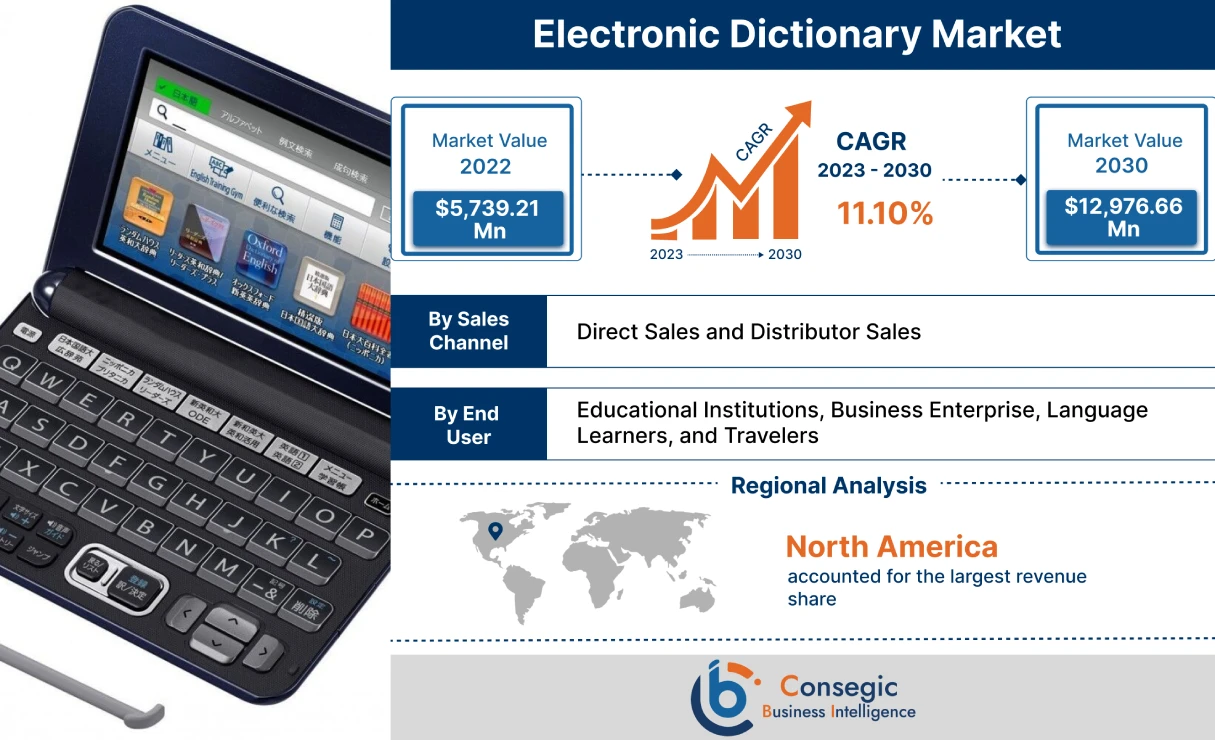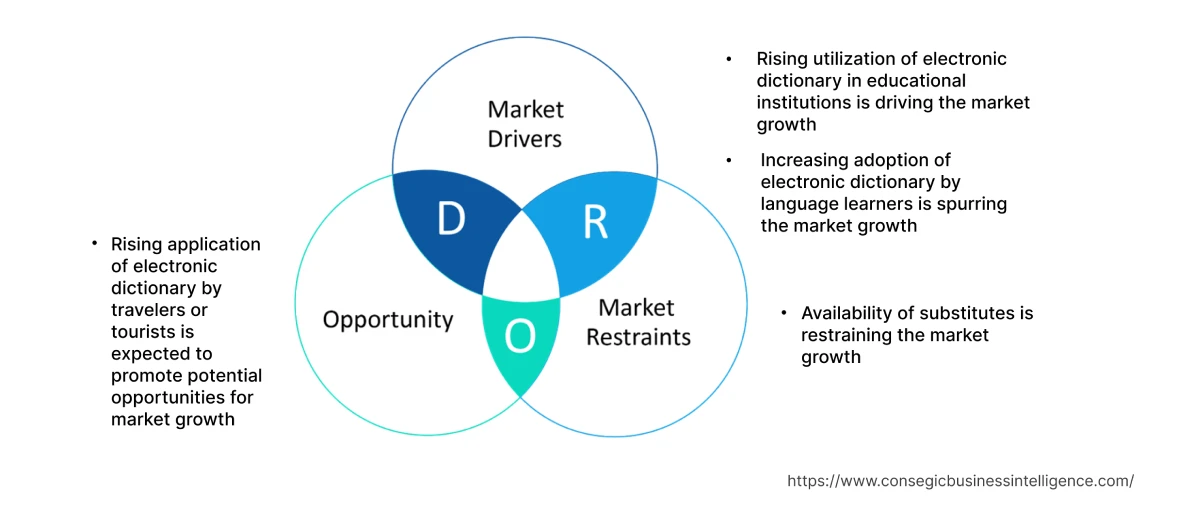- Summary
- Table Of Content
- Methodology
Electronic Dictionary Market Introduction :
Global Electronic Dictionary Market Size is estimated to reach over USD 12,976.66 Million by 2030 from a value of USD 5,739.21 Million in 2022, growing at a CAGR of 11.10% from 2023 to 2030.
Electronic Dictionary Market Definition & Overview:
An electronic dictionary consists of lexicographic information that is primarily stored and accessed through a computer. The data of in it exists in digital form and can be accessed through various media. Additionally, electronic dictionaries offer several benefits including excellent portability, compact form factor, and a wide range of words and expressions as compared to a conventional paper dictionary. The aforementioned benefits of electronic dictionaries are key determinants for increasing their utilization by educational institutions, business enterprises, language learners, and travelers among others.
Electronic Dictionary Market Insights :
Key Drivers :
Rising utilization in educational institutions
Electronic dictionaries are vital assets for educational institutions. Electronic dictionaries help students in vocabulary expansion, language learning, and exam preparations, among others. Moreover, electronic dictionaries also provide teachers with additional resources for language instruction and assessment. The aforementioned benefits of electronic dictionaries are key determinants for increasing their utilization in educational institutions.
Factors including the rising adoption of higher education enrolments, growing international student mobility trends, and increasing government initiatives and funding for the development of educational institutes are among the key prospects driving the adoption of electronic dictionary. For instance, according to the India Brand Equity Foundation, the Indian Government has taken multiple initiatives such as the Foreign Educational Institutions Bill and National Accreditation Regulatory Authority Bill for Higher Education to promote the educational industry comprising of schools and colleges in India.
Additionally, according to the European Union, approximately 18 million students were enrolled in tertiary education in 2020, among which 60% studied bachelor's degrees. Analysis of market trends concludes that the rising student enrolments in educational institutions is driving the utilization of electronic dictionaries to helps students in vocabulary expansion, language learning, and exam preparations, in turn driving the electronic dictionary market demand.
Increasing adoption by language learners
Electronic dictionaries provide language learners with an efficient and convenient tool for pronunciation guidance, vocabulary building, and language comprehension. Moreover, electronic dictionaries offer instant access to definitions and language translations, which makes the learning process more interactive and engaging. The above benefits of electronic dictionary is increasing its adoption by language learners.
Factors including the rising globalization, expansion of business operations abroad, increasing demand for cross-border communication, and growing number of international language learners are primary aspects driving the market proliferation.
According to Duolingo, a U.S.-based company specializing in language learning, the company recorded over 500 million language learners across the world in 2021. Duolingo further states that English, Spanish, French, German, and Japanese were among the top five popular languages in 2021. Analysis of market trends concludes that the rising number of international language learners is increasing the adoption of e-dictionary for utilization in pronunciation guidance, vocabulary building, and language comprehension, which in turn proliferating the electronic dictionary market demand.
Key Restraints :
Availability of substitutes
Electronic dictionary has various substitutes such as smartphones, along with internet-accessible options including Google Translate, and others. Comparatively, the substitutes have similar functionalities, characteristics, and applications, which is a key factor limiting the market expansion.
For instance, smartphones are an ideal alternative to electronic dictionaries. The utilization of smartphones will enable users to download various dictionary apps with similar features as electronic dictionaries. Moreover, the utilization of smartphones to download and use dictionary app is relatively more economical option as compared to electronic dictionaries. Assessment of market trends suggests that the availability of various substitutes for electronic dictionary is limiting the market proliferation.
Future Opportunities :
Rising application by travelers or tourists
The rising application of electronic dictionary by international travelers or tourists is expected to present potential opportunities for the growth of the electronic dictionary market. The utilization of electronic dictionaries enables travelers or tourists to communicate effectively in foreign countries by offering instant translations and language support. Electronic dictionaries travelers or tourists to overcome language barriers and improve the overall travel experience, which are primary aspects for increasing its utilization by tourists or travelers.
Factors including the rising travel trends, higher disposable income, and increasing tourism activities are projected to promote lucrative growth aspects for the market. For instance, according to the Singapore Tourism Board, approximately 1.5 million tourist arrivals were observed in Singapore during the first half of 2022, nearly 12 times more in comparison to the first half of 2021. Analysis of market trends concludes that the rising tourism activities is anticipated to increase the application of e-dictionary to enable tourists to communicate effectively in foreign countries, which in turn is emerging as one of many electronic dictionary market opportunities that will drive market expansion during the forecast period.
Electronic Dictionary Market Report Insights :
| Report Attributes | Report Details |
| Study Timeline | 2017-2030 |
| Market Size in 2030 | USD 12,976.66 Million |
| CAGR (2023-2030) | 11.10% |
| By Sales Channel | Direct Sales and Distributor Sales |
| By End-User | Educational Institutions, Business Enterprise, Language Learners, and Travelers |
| By Region | Asia-Pacific, Europe, North America, Latin America, Middle East & Africa |
| Key Players | CASIO COMPUTER CO. LTD., Canon Electronic Business Machines (H.K.) Co. Ltd., ECTACO Inc., ELLTON ENTERPRISE PTE LTD, APKPure, Merriam-Webster Incorporated, Vasco Electronics, SHARP CORPORATION, iFLYTEK Corporation, Hanvon Technology Co. Ltd. |
Electronic Dictionary Market Segmental Analysis :
Based on the Sales Channel :
Based on the sales channel, the market is bifurcated into direct sales and distributor sales. In 2022, the distributor sales segment accounted for the highest electronic dictionary market share. The distributor sales channel comprises of both offline and online modes. In online mode, e-dictionary can be bought from e-commerce websites such as eBay, Alibaba, Amazon, and others. The offline mode includes the distribution of dictionary through retail stores, specialist stores, and others. Moreover, the purchase of dictionary from a distributor also benefits the consumer in selecting the best product available in the market.
For instance, CASIO and ECTACO Inc. are among few of the manufacturers that offer a range of electronic dictionaries for purchase through various e-commerce websites including Amazon, eBay, and others. Analysis of electronic dictionary market trends concludes that the increasing availability of electronic dictionaries in online distributor sales channel is a prime factor proliferating the growth of the segment.
The direct sales segment is anticipated to register fastest CAGR growth during the forecast period. In direct sales channel, products are directly sold to customers through various physical outlets such as company outlets, and others. Moreover, the direct sales channel also consists of online mode, in which the manufacturers sell the products through their own company websites. Additionally, purchasing e-dictionary from direct sales channel offers various benefits including higher product quality, competitive pricing, faster response time, and higher return on investments, which are primary factors increasing the purchase of electronic dictionaries from direct sales channel.
For instance, Ellton Enterprise PTE Ltd. is among few of the manufacturers that offer a range of electronic dictionaries for direct purchase through company website. Therefore, the increasing availability of dictionary in direct sales channels, attributed to its above benefits, is a key factor projected to drive the electronic dictionary market growth.
Based on the End-User :
Based on the end-user, the market is segregated into educational institutions, business enterprise, language learners, and travelers. In 2022, the educational institutions segment accounted for the highest electronic dictionary market share of 33.4% in the market. Factors including the increasing adoption of higher education enrolments, growing international student mobility, and rising government funding and initiatives for the development of educational institutes are key prospects driving the proliferation of the educational institution segment.
For instance, according to the Ministry of Education, India, the total enrolment of students in primary to higher secondary school education in India reached 255.7 million in FY 2021-22, witnessing an increase from 253.8 million enrolments in FY 2020-21. Therefore, the rising student enrolments in educational institutions is driving the utilization of electronic dictionaries to helps students in vocabulary expansion, language learning, and exam preparations, in turn proliferating the electronic dictionary market growth.
The language learners' segment is expected to witness fastest CAGR growth during the forecast period. Analysis of electronic dictionary market trends concludes that the expansion of language learners segment is attributed to several factors including the rising globalization, expansion of business operations abroad, increasing demand for cross-border communication, and growing number of international language learners.
For instance, according to the ELT Council, Malta, foreign students attending English language courses at local licensed ELT (English Language Teaching) institutions in Malta reached 27,853 individuals, representing a rise of 68.9% in comparison to 2020. Electronic dictionaries provide language learners with an efficient and convenient tool for pronunciation guidance, vocabulary building, and language comprehension along with instant access to definitions and language translations. Thus, the rising prevalence of international language learners is projected to drive the adoption of e-dictionary, in turn driving the market expansion the forecast period.
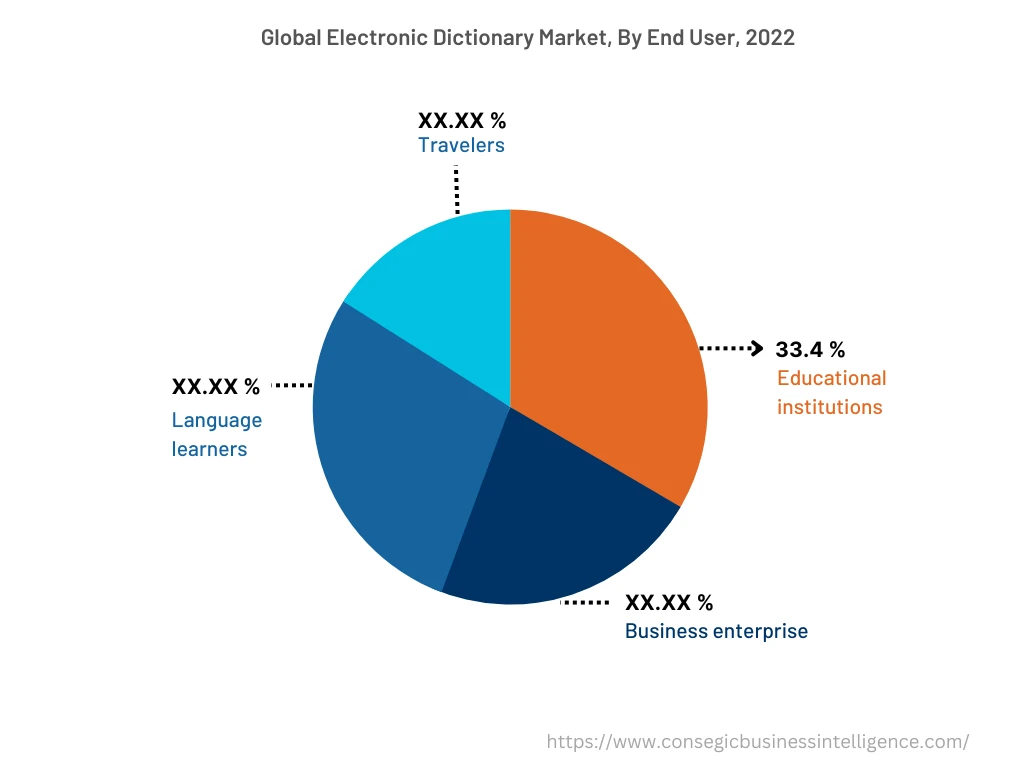
Based on the Region :
The regional segment includes North America, Europe, Asia Pacific, Middle East and Africa, and Latin America.
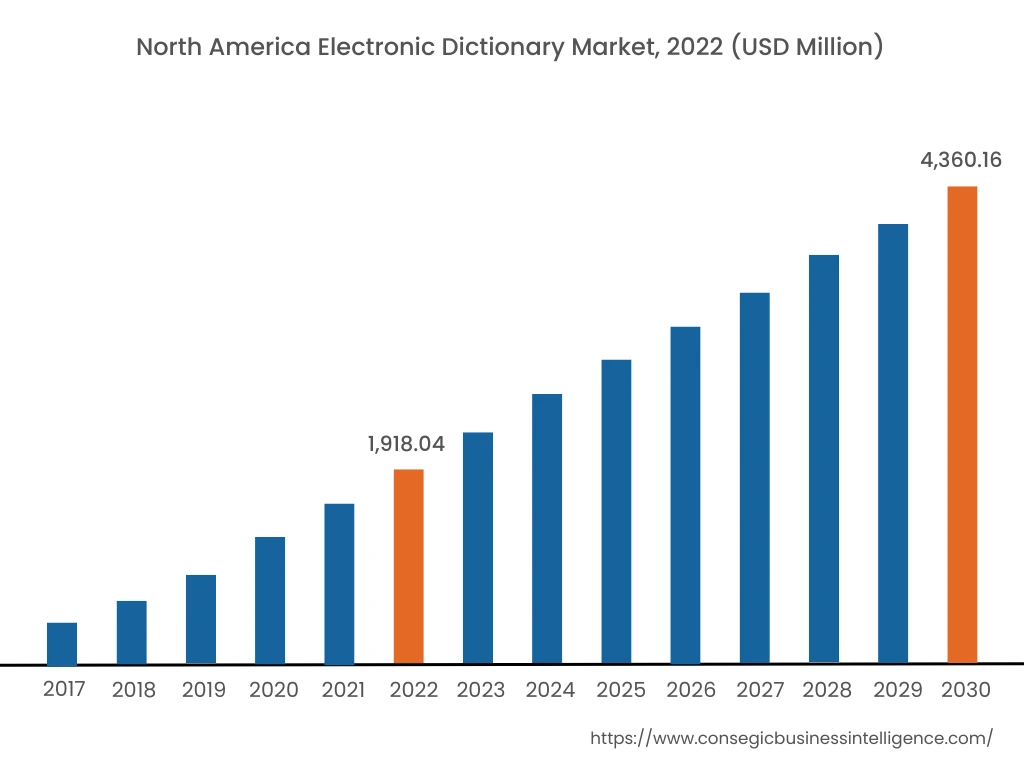
North America accounted for the largest revenue share of USD 1,918.04 Million in 2022 and is expected to reach USD 4,360.16 Million by 2030, registering a CAGR of 11.2% during the forecast period. In addition, in the region, the U.S. accounted for the maximum revenue share of 52.42% in the same year. The adoption of e-dictionary in the North American region is primarily driven by its utilization in educational institutions including schools and colleges along with growing international student mobility among others. The electronic dictionary market analysis concluded that the increasing adoption of e-dictionary by students for vocabulary expansion, language learning, and exam preparations is among the significant factors driving the market proliferation in the region.
Additionally, factors including rising tourism activities and increasing utilization of e-dictionary by tourists to communicate effectively in foreign countries through instant translations and language support are driving the market expansion in the region. For instance, according to Trading Economics, the number of tourist arrivals in the United States reached up to 5.2 million in March 2023, depicting an increase of 26.8% as compared to 4.1 million in February 2023. The above factors are further driving the market proliferation in North America.
Asia-Pacific is expected to register fastest CAGR growth of 11.4% during the forecast period. The rising pace of urbanization and development is promoting lucrative opportunities for market expansion in the Asia-Pacific region. The electronic dictionary market analysis concluded that the factors including the expansion of educational institutions and rising adoption of higher education enrolments are among the major prospects fostering the market proliferation in the region.
For instance, according to the Ministry of Education of China, currently, there are over 529,300 educational institutions in China with total student enrolments of 291 million in 2021. In 2021, gross enrolment in higher education in China reached approximately 57.8%, depicting an increase of 3.4% in comparison to 2020. Therefore, the expansion of educational institutions and rising adoption of higher education enrolments is anticipated to drive the utilization of electronic dictionary by students for learning activities, thereby, boosting the market proliferation in the Asia-Pacific region during the forecast period.
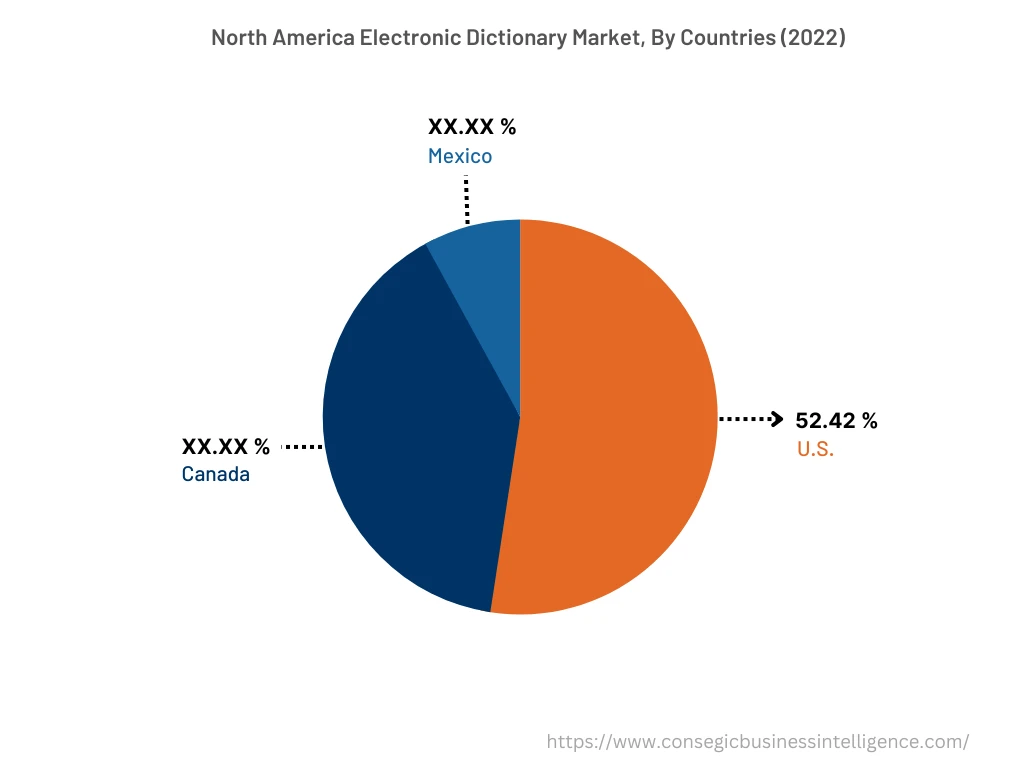
Top Key Players & Market Share Insights:
The market is highly competitive with major players providing products to the national and international markets. The companies operating in electronic dictionary industry are adopting several strategies in research and development (R&D), product innovation, and application launches to hold a strong position in market. Key players in the market include-
- CASIO COMPUTER CO. LTD.
- Vasco Electronics
- SHARP CORPORATION
- iFLYTEK Corporation
- Hanvon Technology Co. Ltd.
- Canon Electronic Business Machines (H.K.) Co. Ltd.
- ECTACO Inc.
- ELLTON ENTERPRISE PTE LTD
- APKPure
- Merriam-Webster Incorporated
Recent Industry Developments :
- In February 2024, UNDP Bangladesh launched Sign Language E-Dictionary on the occasion of International Mother Language Day 2024. The launch promotes availability of dictionary for people with hearing and speech deficiencies.
Key Questions Answered in the Report
What is electronic dictionary? +
An electronic dictionary consists of lexicographic information that is primarily stored and accessed through a computer. The data of an electronic dictionary exists in digital form and can be accessed through various media.
What specific segmentation details are covered in the electronic dictionary report, and how is the dominating segment impacting the market growth? +
For instance, by sales channel segment has witnessed distributor sales as the dominating segment in the year 2022, owing to its range of benefits including higher accessibility to a variety of products, ease of use, and high flexibility.
What specific segmentation details are covered in the electronic dictionary market report, and how is the fastest segment anticipated to impact the market growth? +
For instance, by end-user segment has witnessed language learners as the fastest-growing segment during the forecast period due to the rising adoption of electronic dictionary by international language learners for pronunciation guidance, vocabulary building, and language comprehension along with instant access to definitions and language translations.
Which region/country is anticipated to witness the highest CAGR during the forecast period, 2023-2030? +
Asia-Pacific is anticipated to register fastest CAGR growth during the forecast period due to rapid pace of urbanization, expansion of educational institutions, rising adoption of higher education enrolments, and other related factors.
